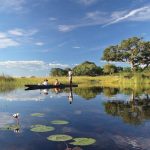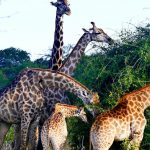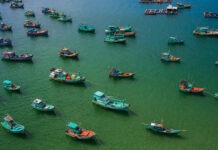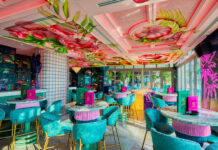Botswana is well known for having some of the best wilderness and wildlife areas on the African continent. With a full 38 percent of its total land area devoted to national parks, reserves and wildlife management areas -for the most part unfenced, allowing animals to roam wild and free – travel through many parts of the country has the feeling of moving through an immense Nature wonderland.
Botswana is a rarity in our overpopulated, over-developed world. It is one of the last great refuges for nature’s magnificent pageantry of life. Experience here the stunning beauty of the world’s largest intact inland Delta the Okavango; the unimaginable vastness of the world’s second largest game reserve the Central Kalahari Game Reserve; the isolation and other-worldliness of the Makgadikgadi uninhabited pans the size of Portugal; and the astoundingly prolific wildlife of the Chobe National Park.
Botswana is the last stronghold for a number of endangered bird and mammal species, including Wild Dog, Cheetah, Brown Hyena, Cape Vulture, Wattled Crane, Kori Bustard, and Pel’s Fishing Owl. This makes your safari experience even more memorable, and at times you will feel simply surrounded by wild animals.
The first – and most lasting impressions will be of vast expanses of uninhabited wilderness stretching from horizon to horizon, the sensation of limitless space, astoundingly rich wildlife and bird viewing, night skies littered with stars and heavenly bodies of an unimaginable brilliance, and stunning sunsets of unearthly beauty.
As well, with more and more cultural tourism options on offer, you will be charmed by the people of Botswana, visiting their villages and experiencing first-hand their rich cultural heritage. But perhaps most of all, Botswana’s greatest gift is its ability to put us in touch with our natural selves. It offers that vital link so keenly felt by inhabitants of the developed world, a pervasive void we feel but often cannot name our connectedness with nature and the astonishing diversity of plants and animals to be explored.
The Okavango Delta

Location and size
Situated in north-west Botswana in the Kalahari Basin, the area of the Okavango Delta varies between 15 000 and 22 000 square kilometres, depending on season and annual flood regimes. The Moremi Game Reserve (5 000 square kilometres) is located in the eastern part of the Okavango Delta and has an abundance of a variety of wildlife.
Habitat
The Delta’s extremely diverse habitat comprises extensive permanent waterways and swamps, seasonally flooded grasslands and floodplains and dense woodland. The Okavango Delta owes its existence to the great Okavango River which flows from the Angolan Highlands (where it is known as the Cubango River), across Namibia’s Caprivi Strip and into the dry and flat Kalahari Desert. Each year the Okavango River discharges an unbelievable 11 cubic kilometres of water into the Delta; most is either evaporated, transpired or percolated; none of it flows an ocean.
Best time to go
The Okavango can be visited any time of year, but with the peak of the annual flood coinciding with Botswana’s dry season (April to October), resulting in great migrations of plains game from the dry Kalahari savannahs, wildlife viewing is then at its best.
Famous for
The 1000th UNESCO WORLD Heritage Site (2014), Africa’s largest, most intact endorheic (inland) delta, the main tourist attraction of Botswana, safe haven for several highly endangered species, such as cheetah, white rhinoceros, black rhinoceros, wild dog, lion, wattled crane, six species of vultures and other threatened birds; a birding hotspot. The Okavango Delta ecosystem supports a staggering 89 recorded species of fish, 482 species of birds, 130 species of mammals, 64 species of reptiles, 35 species of amphibians and 1061 species of plants!
Don’t miss:
Mokoro (traditional dug-out canoe) safaris; a visit to a private concession, which allows for a more exclusive and personalised experience, as well as extended activities, including walking, horse-back safaris, off-roading and night game drives.
CHOBE NATIONAL PARK

Location and size
The Chobe River forms the northern boundary of the 11 700 square kilometre Chobe National Park, situated in North-Eastern Botswana. The river forms the international border with Namibia. It originates in Angola, where it is called the Kwando River, then flows through the Linyanti area (Namibia and Botswana), where it is called the Linyanti River, then finally flows into Botswana where it is called the Chobe River, eventually draining into the Zambezi River.
Habitat
The Riverfront area of the Chobe National Park is a forested escarpment made up of largely teak and mahogany trees, eventually dropping off to the permanent river, with accompanying seasonal floodplains and sandbar islands.
Best time to go
Between April and November, the concentration of wildlife is at its greatest. For birdwatchers, the Chobe River is an excellent destination all year round. Many migrant birds arrive between November through to early April.
Famous for
Home to the largest concentration of elephants on earth, as well as large herds of zebra, cape buffalo, giraffe and impala, and lesser observed antelope such as sable, roan and lechwe. Predators such as lion, African wild dog and leopard are also frequently seen along the river.
Don’t miss:
The afternoon river cruise – absolutely stunning sunsets!
MAKGADIKGADI AND NXAI PANS NATIONAL PARK

Location and size
Situated in northern Botswana, the entire Makgadikgadi Pans network encompasses over 30000 square kilometres; the largest single pan is about 4900 square kilometres. Makgadikgadi/Nxai Pans National Park is part of this vast network, stretching for approximately 3900 square kilometres.
Habitat
The pans themselves are devoid of vegetation and life in the dry season. The park is primarily grassland, punctuated by picturesque palm islands and stands of acacias. The Boteti River, situated in the western reaches of the park, is surrounded by denser areas of vegetation, having been dry for 30 years, it is currently the area’s only natural permanent water source.
Best time to go
To properly experience the other worldly nature of the pans, go in the dry season (June-October). At this time, the zebras and wildebeest congregate in the western side of the park, around the Boteti River. The zebra migration is best experienced after the rains (November-March), when mass herds populate the eastern areas of the park.
Famous for
The surreal landscape of the pans and their Stone Age archaeological treasures, many of which still lie buried just under the surface. After the rains, the wildlife takes centre stage, with Africa’s second largest zebra migration and the arrival of one of just two breeding populations of Greater Flamingo on the African continent.
Don’t miss
The opportunity to ride across the pans by quad bike or on horse-back, and the most intimate encounter imaginable with the charismatic meerkats.
SAVUTI

Location and size
The entire Savute region measures approximately 5000 square kilometres and occupies the south-western corner of Chobe National Park.
Habitat
The central, publicly accessible area comprises three distinct habitats: the Channel (when it is flowing), Hills and Marsh. Bordering this are large areas of sandy soils dominated by mophane woodland and Kalahari apple-leaf trees.
Best time to go
Predators, (e.g. lions) can be seen all year round. The wet summer months (November to March) see the arrival of the country’s second largest zebra migration, as well as dozens of migratory bird species, including carmine bee-eaters. Montague’s harriers and black-winged pratincoles.
Famous for
Its mercurial Channel, which has flowed for just five years in the last four decades; its permanent population of elephant bulls; predator sightings and its unusual predator behavior. The Marsh lion pride is partially comprised of descendants of the great elephant-hunting super-pride of the early 2000s, which numbered 38 at its peak. Several resident leopards were also known to fish in the Channel when it was flowing, specialising in some of the levitation catfish that roamed to depths.





























